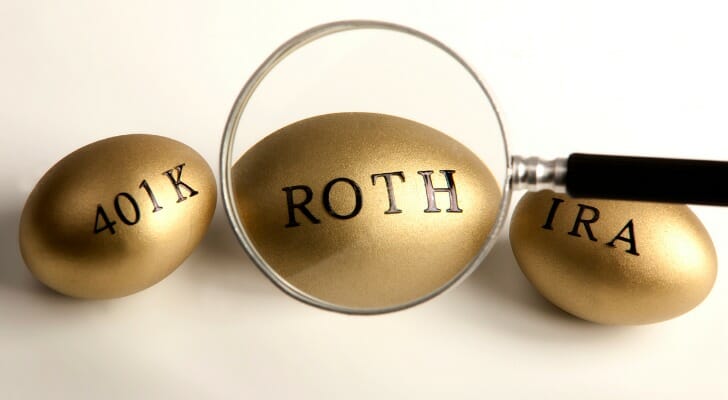Rolling over a 401(k) to a Roth IRA involves transferring funds from an employer-sponsored retirement plan into an account where future qualified withdrawals are tax-free. Because Roth IRAs are funded with after-tax dollars, the amount rolled over from a pre-tax 401(k) is generally subject to income tax in the year of the conversion. This type of rollover can offer greater flexibility in investment choices and no required minimum distributions (RMDs) during the account holder’s lifetime, but it also requires careful planning to account for the potential tax impact.
If you’re interested in a Roth conversion or other strategic moves for your retirement plan, consult a financial advisor first. This matching tool can connect you with fiduciary advisors for free.
Understanding the Roth Conversion Process
Contributions to your 401(k) plan were made on a pre-tax basis. This means your employer deducted them from your taxable salary when reporting your income to the IRS. Same goes for any employer matches. So you have yet to pay taxes on any contributions or accrued earnings.
Traditional IRAs are also tax-advantaged. The difference, of course, is that individuals rather than employers send their contributions to their financial institutions and claim the deduction when filing their taxes. So like 401(k) balances, the money in an IRA is tax-deferred. You won’t owe taxes on it until you retire and start taking distributions.
This is why rolling over your 401(k) to a traditional IRA is fairly straightforward. It’s an apples-to-apples transaction.
By contrast, you fund a Roth IRA with after-tax dollars. That means you pay taxes on your contributions upfront. The tradeoff is that all earnings are tax-free. So when you retire and start making withdrawals, you will owe no taxes. Also, a Roth IRA doesn’t have RMDs like its traditional counterpart, so you can leave the money untouched indefinitely if you prefer.
No doubt, there are significant advantages to moving your 401(k) money to a Roth IRA. But, as noted earlier, it will be a taxable event. You will owe taxes not only on your contributions and your company’s contributions if it has a matching program, but also on your earnings, which include capital gains and dividends. This bump in income could boost you to a much higher income bracket so that you are paying more tax than if you left the money in a traditional IRA and paid taxes as you made withdrawals in retirement.
Your ability to contribute to a Roth IRA is based on your income and tax filing status. If a 401(k) rollover pushes you over the allowed limit for your filing status, you won’t be able to make a Roth IRA contribution for the year. You can make a full contribution to a Roth IRA for 2025 if:
- You’re married filing jointly and have a modified adjusted gross income (MAGI) of less than $236,000
- You’re single or head of household and have a MAGI of less than $150,000
Because the taxation of your money is changing, the switch from a traditional IRA to a Roth is called a conversion rather than a rollover. More importantly, it is a permanent process. So you should make sure this is what you really want to do before you do it.
Direct and Indirect 401(k) Rollovers
Before you roll over your 401(k), you’ll need to open an IRA account. You can do this at virtually any major brokerage firm, mutual fund company or robo-advisor. Do some research, then head to your financial institution’s website to open your account. At some point, you’ll want to talk to a customer representative to find out whether the rollover and conversion can be done at once or if they are done sequentially. If it’s the former case, you’ll just have to pick your investments once. If it’s the latter, you’ll want to keep the money liquid in the IRA before converting to a Roth.
Once you’ve opened the IRA, you can contact the company managing your 401(k) account to begin the rollover process. You can do this online or over the phone. Your 401(k) plan administrator will then transfer your funds into your new IRA account. This is called a trustee-to-trustee or direct rollover, and it’s the easiest way to do it.
Another path is an indirect rollover. In this case, the balance of the account is distributed directly to you, typically as a check. You’ll have 60 days from the date you receive the funds to transfer the money to your custodian or IRA company. If you don’t deposit the funds within the 60 days, the IRS will treat it as a taxable withdrawal, and you’ll face a 10% penalty if you’re younger than 59 ½. This risk is why most people choose the direct option.
With either rollover option, you’ll also have to make sure you’ve satisfied any special requirements the company might have. If you’re looking to roll over only a portion of your 401(k), you’ll need to check with your plan administrator to see if that’s something they allow.
Paying Taxes on Your Contributions
The point of a Roth IRA is that the money gets taxed as income upfront, then grows tax-free. But the money in your 401(k) was shielded from taxes. So you’ll now need to pay income tax on that money so that it qualifies for a Roth.
The funds you roll over are added to your taxable income for the year you do the rollover. Income taxes you owe will be calculated from that new total. Since the “income” from your IRA isn’t coming from a paycheck, though, the tax you owe on it won’t be withheld. It’ll have to come out of your pocket, and to avoid a penalty, you may need to make an estimated tax payment before filing your taxes for the year.
You’ll need to make an estimated tax payment if the taxes withheld from your paycheck aren’t enough to cover at least:
- A) 90% of the taxes you’ll owe for the tax year of your rollover or
- B) 100% of the taxes you paid for the previous tax year (the smaller of the two figures).
Once you know your estimated payment, you can either pay it all at once or split the amount between the quarters remaining in the tax year. Quarterly estimated tax payments are due on or before April 15, June 15, Sept. 15 and Jan. 15 of the next year.
If you overestimate how much your tax bill is going up and overpay your estimated tax payments, that’s OK. You’ll get a refund if you end up paying more than you owe.
If you’re converting a large balance to a Roth, your tax bill for the year could go up substantially. That’s especially true if the extra “income” pushes you into a higher tax bracket. To lower this impact, you could convert only part of the traditional IRA over two or more years. By spreading out your conversion, you avoid having a huge tax bill to pay all at once, and perhaps keep yourself in a lower bracket.
What Are Qualified Withdrawals?
Qualified withdrawals from a Roth IRA are distributions that meet specific IRS criteria to be tax-free. To qualify, the account must have been open for at least five years, and the withdrawal must occur after the account holder reaches age 59 ½, becomes disabled or uses up to $10,000 for a first-time home purchase.
Beneficiaries who inherit a Roth IRA can also take qualified withdrawals if the five-year rule is met. Because contributions to a Roth IRA are made with after-tax dollars, meeting these requirements allows both the original contributions and any investment earnings to be withdrawn without federal income tax.
Roth 401(k)s as an Alternative
A Roth 401(k) combines the employer-sponsored nature of the traditional 401(k) with the tax structure of the Roth IRA. If your employer offers this type of plan, you’ll contribute after-tax money to your account and you won’t owe taxes when you start receiving distributions. If your employer offers a match, though, that money is in a traditional 401(k) plan. So if you choose to convert it, you will owe taxes on it the year you do so.
If you’re looking to do a rollover from a Roth 401(k) to a Roth IRA (minus any company match), the process is quite simple. All you’ll have to do is follow the same steps as if you were rolling over a traditional 401(k) to a traditional IRA. The tax structure is staying the same. If you’re looking to convert your Roth 401(k) into a traditional IRA, you’re out of luck. Unfortunately, this isn’t possible, since you can’t un-pay taxes on the money in your Roth 401(k).
Bottom Line
Rolling a 401(k) over into a Roth IRA could be a wise move if you expect to be in a higher tax bracket in the future since withdrawals from a Roth IRA are tax free. Just remember that you’ll pay taxes in the year that you do the conversion.
Tips for Saving for Retirement
- A financial advisor can help you find ways to save more for retirement. Finding a financial advisor doesn’t have to be hard. SmartAsset’s free tool matches you with vetted financial advisors who serve your area, and you can have a free introductory call with your advisor matches to decide which one you feel is right for you. If you’re ready to find an advisor who can help you achieve your financial goals, get started now.
- Boost your savings rate as your income grows, even by 1% annually. Small increases can significantly improve your retirement outlook without a major impact on your current budget.
Photo Credit: ©iStock.com/jygallery, ©iStock.com/Denis Kalinichenko, ©iStock.com/DNY59


